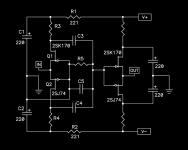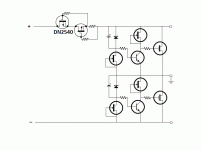daltvi,
Here is a reasonable start. Make sure to add back the filter resistors and capacitors from the article and/or use a quiet supply.
The gain was wrong on this example. Change the 1.5K resistors to 750 ohm, and the voltage supplies to +/-25V and give it a try. You need one set of these for each channel, left and right of a stereo configured 9018.
Looking forward to what you think of the sound.
Cheers,
Dave
Here is a reasonable start. Make sure to add back the filter resistors and capacitors from the article and/or use a quiet supply.
The gain was wrong on this example. Change the 1.5K resistors to 750 ohm, and the voltage supplies to +/-25V and give it a try. You need one set of these for each channel, left and right of a stereo configured 9018.
Looking forward to what you think of the sound.
Cheers,
Dave
Hi.
I'm quite intrigued by the designs on this forum. If I have followed correctly, for a PCM1738 (Shanling CDT80 CD) 2.48ma p-p & 2.5v offset, I could use the design of post 261 with the addition of op amps as post 241. I could re-use the original op amps OPA627, the data sheet would seem to advise +/- 5v supply to reduce temperature variations.
A few questions;
1 - the j-fets, do I need grade GR, BL or V?
2 - what would be the (single ended) output level for the 2.48ma input?
I would build one channel initially, then compare L to R before proceeding with the second.
I'm quite intrigued by the designs on this forum. If I have followed correctly, for a PCM1738 (Shanling CDT80 CD) 2.48ma p-p & 2.5v offset, I could use the design of post 261 with the addition of op amps as post 241. I could re-use the original op amps OPA627, the data sheet would seem to advise +/- 5v supply to reduce temperature variations.
A few questions;
1 - the j-fets, do I need grade GR, BL or V?
2 - what would be the (single ended) output level for the 2.48ma input?
I would build one channel initially, then compare L to R before proceeding with the second.
Looking forward to build
This I/V looks good! Simple circuit with good sounding devices and measures well - what could go wrong?
Input impedance of 15-20 ohms is no problem for most converters. Coupling capacitors are no problem IME... Just look at the schematic of any high-end studio mixer
-Alex
This I/V looks good! Simple circuit with good sounding devices and measures well - what could go wrong?
Input impedance of 15-20 ohms is no problem for most converters. Coupling capacitors are no problem IME... Just look at the schematic of any high-end studio mixer
-Alex
Last edited:
Let´s see... Starting with the schematic above, considering 1mA peak current from AD186x, I select drain resistors of 3.3K and have an output of (3.3K/2)*1m = 1.65V peak = 1.17V rms.
Starting with the schematic above, considering 1mA peak current from AD186x, I select drain resistors of 3.3K and have an output of (3.3K/2)*1m = 1.65V peak = 1.17V rms.
Using matched fets at 10mA idss, the supply rails have to be at least: 15+((3300+221)*10m) = 50.2V.
The drain resistors for the buffer can be 3.3K as well.
R5 will go up to 680K, so the coupling cap can be 0.1 uF. This makes a high-pass at 1/(2*3.1415*680K*0.1u) = 2.34 Hz (-3db).
There´s plenty of places to put LPF. The buffer can be configured as sallen-key LP. This is TBD by measurements and listening.
Looks good?
-Alex
 Starting with the schematic above, considering 1mA peak current from AD186x, I select drain resistors of 3.3K and have an output of (3.3K/2)*1m = 1.65V peak = 1.17V rms.
Starting with the schematic above, considering 1mA peak current from AD186x, I select drain resistors of 3.3K and have an output of (3.3K/2)*1m = 1.65V peak = 1.17V rms.Using matched fets at 10mA idss, the supply rails have to be at least: 15+((3300+221)*10m) = 50.2V.
The drain resistors for the buffer can be 3.3K as well.
R5 will go up to 680K, so the coupling cap can be 0.1 uF. This makes a high-pass at 1/(2*3.1415*680K*0.1u) = 2.34 Hz (-3db).
There´s plenty of places to put LPF. The buffer can be configured as sallen-key LP. This is TBD by measurements and listening.

Looks good?
-Alex
This is an idea for the supply, most of it taken from Shunt Regulation Part 2 - diyAudio
Single secondary, lots of R and C, cascode CCS with depletion mode mosfet, and the ground is set by the shunt regs. One supply for both channels.
What do you think Patrick?
-Alex
Single secondary, lots of R and C, cascode CCS with depletion mode mosfet, and the ground is set by the shunt regs. One supply for both channels.
What do you think Patrick?
-Alex
Attachments
- Home
- Amplifiers
- Pass Labs
- Zen I/V Converter

